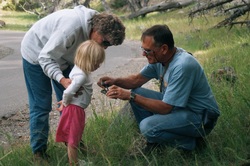Teaching Philosophy

I believe that we learn best when we are involved in our own education. Participating in the lecture, activity, studio, presentation or other lesson allows for the information or skill to embed itself into our minds, our bodies, and ourselves. Howard Gardner writes of his theory of Multiple Intelligences wherein he posits that we all learn in different ways. Through these intelligences, I reach out to engage students in the content at hand in order to involve each student, be it through a lesson with a kinetic component, a visual aspect, or another intelligence.
It is also important that my students interact with one another and help one another learn. This each one, teach one philosophy is a crucial part of my classroom technique. Students learn from one another as well as from the instructor (and always the instructor learns from the students). One of my favorite assignments to give in a visual arts setting is to have my students create an original work of art based on a topic we have been researching. On presentation day, they bring their pieces along with their research and they give a brief presentation on what they did and why. These presentations and pieces are always of such strength and insight and everyone in the classroom benefits from their being shared.
I aspire to Paolo Friere’s philosophy of teaching wherein we move beyond the ‘banking’ concept of education where deposits of knowledge are made in to students; rather, students are empowered to develop their own ideas and approaches to content. In Pedagogy of the Oppressed, he said too often teaching assumes students are empty containers to be filled by the teachers. Through an inquiry-based and student-centered approach, I work with students to help them develop themselves into life-long learners. I employ active learning wherein students work through a research question in small groups or pairs rather than by simply telling them what to think and do and how to do it.
Be it in the classroom, online, or at the reference desk, I am constantly inspired by Friere, Gardner and others like them. I strive to empower my students to teach themselves, for the rest of their lives, beyond their time in the classroom. I want to stimulate inquiry, enable independent and critical thought, and facilitate students’ development for and by themselves.
It is also important that my students interact with one another and help one another learn. This each one, teach one philosophy is a crucial part of my classroom technique. Students learn from one another as well as from the instructor (and always the instructor learns from the students). One of my favorite assignments to give in a visual arts setting is to have my students create an original work of art based on a topic we have been researching. On presentation day, they bring their pieces along with their research and they give a brief presentation on what they did and why. These presentations and pieces are always of such strength and insight and everyone in the classroom benefits from their being shared.
I aspire to Paolo Friere’s philosophy of teaching wherein we move beyond the ‘banking’ concept of education where deposits of knowledge are made in to students; rather, students are empowered to develop their own ideas and approaches to content. In Pedagogy of the Oppressed, he said too often teaching assumes students are empty containers to be filled by the teachers. Through an inquiry-based and student-centered approach, I work with students to help them develop themselves into life-long learners. I employ active learning wherein students work through a research question in small groups or pairs rather than by simply telling them what to think and do and how to do it.
Be it in the classroom, online, or at the reference desk, I am constantly inspired by Friere, Gardner and others like them. I strive to empower my students to teach themselves, for the rest of their lives, beyond their time in the classroom. I want to stimulate inquiry, enable independent and critical thought, and facilitate students’ development for and by themselves.
Teaching experience
I have been teaching in schools, museums and libraries since 1991. I began by working as a TA in the photography classes at the University of Nevada, Reno and went on to my first formal teaching job as instructor for the Art Attack! program in Reno. I continued by teaching English at the local community college until my husband and I moved to San Diego, CA. While in San Diego, I initially worked for Planned Parenthood where I taught women about birth control and their sexuality and then began working for the Institute for Arts Education, the Museum of Photographic Arts and other museums.
We moved to Seattle in 1999 and I continued my teaching practice at institutions including Cornish College of the Arts in the library as well as an adjunct instructor in the Art, Design, and Humanities departments. I've also taught at Youth in Focus, the Frye Art Museum, the University of Washington's Art department, the Henry Art Gallery, the Goodlad Institute at UWBothell, and the Photographic Center Northwest.
We moved to Seattle in 1999 and I continued my teaching practice at institutions including Cornish College of the Arts in the library as well as an adjunct instructor in the Art, Design, and Humanities departments. I've also taught at Youth in Focus, the Frye Art Museum, the University of Washington's Art department, the Henry Art Gallery, the Goodlad Institute at UWBothell, and the Photographic Center Northwest.
